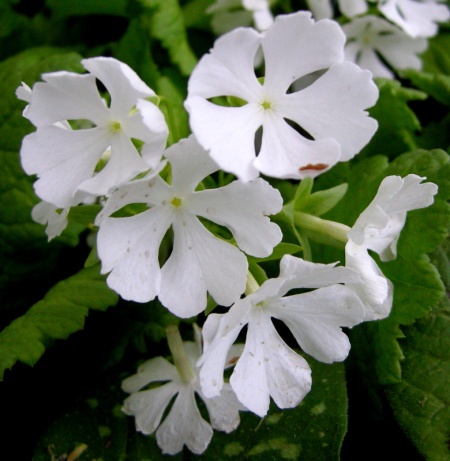Carolyn’s Shade Gardens is a retail nursery located in Bryn Mawr, PA, specializing in showy, colorful, and unusual plants for shade. The only plants that we ship are snowdrops and miniature hostas. For catalogues and announcements of events, please send your full name, location, and phone number (for back up use only) to carolyn@carolynsshadegardens.com. Click here to get to the home page of our website for catalogues and information about our nursery and to subscribe to our blog.
 ‘Belarina Nectarine’ double primrose
‘Belarina Nectarine’ double primrose
.
This weekend Carolyn’s Shade Gardens is holding its second open house sale of the season, and one of the featured plants is primroses. Primroses are a hard sell to gardeners because, as my customers always tell me, they’ve tried primroses and they don’t come back. I usually begin my defense of the hardiness of primroses by asking if they bought the brightly colored varieties often sold in supermarkets and other big box type stores in early spring. We have all done it, who can resist? Unfortunately, those primroses are not suited to our climate and really shouldn’t be marketed as perennials. There are, however, many lovely primroses that come back every year. Here are just a few:
.
 Cowslip primroses are very easily grown in part shade and average soil without supplemental watering. They produce a 6 to 12″ stem topped by nodding, fragrant, lemon-yellow flowers in midspring.
Cowslip primroses are very easily grown in part shade and average soil without supplemental watering. They produce a 6 to 12″ stem topped by nodding, fragrant, lemon-yellow flowers in midspring.
.
 Cowslip primrose, Primula veris, with spring starflower and perennial forget-me-not.
Cowslip primrose, Primula veris, with spring starflower and perennial forget-me-not.
.
 English primrose ‘Old Brick Reds’, P. x polyantha, is very easy to grow in average soil and part shade, multiplying rapidly. The scarlet red flowers with a yellow eye can appear as early as the end of March and last into May. The rosette of wintergreen leaves is bright green. ‘Old Brick Reds’ is a 17th century heirloom primrose given to me by one of my classmates at the Barnes Arboretum. Paired here with fern-leafed corydalis, C. cheilanthifolia.
English primrose ‘Old Brick Reds’, P. x polyantha, is very easy to grow in average soil and part shade, multiplying rapidly. The scarlet red flowers with a yellow eye can appear as early as the end of March and last into May. The rosette of wintergreen leaves is bright green. ‘Old Brick Reds’ is a 17th century heirloom primrose given to me by one of my classmates at the Barnes Arboretum. Paired here with fern-leafed corydalis, C. cheilanthifolia.
.
 Primula kisoana is so rare that it does not appear to have a common name, but that doesn’t mean it is hard to grow. It spreads by underground runners to form patches of velvety, unusually shaped leaves topped by many bright pink flowers in April and May. It doesn’t mind dry soil and has creeped out of the amended beds where I planted it to colonize the edges of the rocks along my woodland path.
Primula kisoana is so rare that it does not appear to have a common name, but that doesn’t mean it is hard to grow. It spreads by underground runners to form patches of velvety, unusually shaped leaves topped by many bright pink flowers in April and May. It doesn’t mind dry soil and has creeped out of the amended beds where I planted it to colonize the edges of the rocks along my woodland path.
.
 Even rarer is the white-flowered form, P. kisoana ‘Alba’.
Even rarer is the white-flowered form, P. kisoana ‘Alba’.
.
 Japanese primroses, P. japonica, come in many different shades from pure white to dark magenta held on 20″ stems and set off beautifully by their 10″ long bright green leaves. The flowers are candelabra form which means that they bloom successively in tiers one over the other for a long period of time in May and June. They are very easy to grow and self-sow readily as long as you plant them in a moist or wet area. They will grow in average soil but will die as soon as you have a drought. I am not sure where I got this photo or I would give proper credit.
Japanese primroses, P. japonica, come in many different shades from pure white to dark magenta held on 20″ stems and set off beautifully by their 10″ long bright green leaves. The flowers are candelabra form which means that they bloom successively in tiers one over the other for a long period of time in May and June. They are very easy to grow and self-sow readily as long as you plant them in a moist or wet area. They will grow in average soil but will die as soon as you have a drought. I am not sure where I got this photo or I would give proper credit.
.
 One of the many forms of Japanese woodland primroses, P. sieboldii, that I have collected over the years.
One of the many forms of Japanese woodland primroses, P. sieboldii, that I have collected over the years.
Japanese woodland primroses (not to be confused with the Japanese primroses described above) are a wonderful addition to the garden because they grow in full dry shade but also thrive in average or even moist soil. They are from Asia and have been cultivated in Japan since the 16th century but are rare in the US. Reportedly over 500 cultivars have been named, and I see how they can become addictive because I keep adding new forms to my garden. They bloom in April and May in colors from white to pink to purple and everything in between. The crinkly green leaves form large patches and effectively block weeds even though they go dormant when it gets hot out.
.
 The flowers of Japanese woodland primrose often have a different color “reverse” (back), here white with lavender pink.
The flowers of Japanese woodland primrose often have a different color “reverse” (back), here white with lavender pink.
.
 They also can have filigreed edges kind of like a doily for a lovely dainty effect.
They also can have filigreed edges kind of like a doily for a lovely dainty effect.
.
 The earliest to bloom in my garden is pure white ‘Snowflake’.
The earliest to bloom in my garden is pure white ‘Snowflake’.
.
 This is the straight species and is one of my favorites. Local readers should make an effort to see Japanese woodland primrose blooming in my garden because the photos don’t do justice to their beauty. They are located under the tree below the birdhouse.
This is the straight species and is one of my favorites. Local readers should make an effort to see Japanese woodland primrose blooming in my garden because the photos don’t do justice to their beauty. They are located under the tree below the birdhouse.
.
 ‘Belarina Valentine’ double primrose
‘Belarina Valentine’ double primrose
Even though they look delicate, the Belarina Series of double primroses has proven to be reliably perennial in my garden. They bloom in late April and May, and the leaves are just emerging right now. I have sited them in an east-facing location between stepping stones under a Japanese maple. The soil probably does not dry out because of the stones and the heavy mulch of leaves and pine needles. If you are looking for a colorful primrose like the non-hardy grocery store varieties, these showy double primroses are just what you want.
.
 ‘Belarina Pink Ice’ double primrose
‘Belarina Pink Ice’ double primrose
.
 ‘Belarina Cobalt Blue’ double primrose
‘Belarina Cobalt Blue’ double primrose
.
 ‘Belarina Nectarine’ double primrose
‘Belarina Nectarine’ double primrose
.
Many of these primroses will be available at the open house sale at Carolyn’s Shade Gardens this Saturday, April 13, from 10 am to 3 pm. The rest will be for sale as they come up because I grow most of them myself. Readers who are not local now know which reliably perennial primroses to ask for at their local nursery.
Carolyn
.
Carolyn’s Shade Gardens is a retail nursery located in Bryn Mawr, Pennsylvania, US, zone 6b. The only plants that we mail order are snowdrops and miniature hostas and only within the US.
If you are within visiting distance and would like to receive catalogues and information about customer events, please send your full name and phone number to carolynsshadegardens@verizon.net. Subscribing to my blog does not sign you up to receive this information.
Nursery Happenings: Our open house sale featuring early spring-blooming shade plants takes place this Saturday, April 13, from 10 am to 3 pm. If you are a customer, you should have gotten an email with all the details. If you can’t come to an event, just email to schedule an appointment to shop. Coming up next is our Great Hosta Blowout where we sell desirable hostas at bargain prices—look for an email.
Facebook: Carolyn’s Shade Gardens has a Facebook Page where I post single photos, garden tips, and other information that doesn’t fit into a blog post. You can look at my Facebook page here or click the Like button on my right sidebar here.
Notes: Every word that appears in orange on my blog is a link that you can click for more information. If you want to return to my blog’s homepage to access the sidebar information (catalogues, previous articles, etc.) or to subscribe to my blog, just click here.




